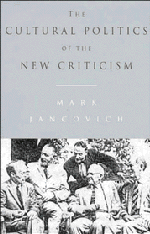Book contents
- Frontmatter
- Contents
- Preface
- List of abbreviations
- Part I The New Criticism and its critics
- Part II The formation of the New Criticism
- Introduction
- 4 John Crowe Ransom: the social relations of aesthetic activity
- 5 Allen Tate: the social organization of literature
- 6 Robert Penn Warren: against propaganda and irresponsibility
- Conclusion: the analysis of a Southern poet
- Part III The establishment of the New Criticism
- Part IV The development of the New Criticism
- Conclusion: Modernism and postmodernism within the American academy
- Conclusion
- Notes
- Bibliography
- Index
4 - John Crowe Ransom: the social relations of aesthetic activity
Published online by Cambridge University Press: 18 December 2009
- Frontmatter
- Contents
- Preface
- List of abbreviations
- Part I The New Criticism and its critics
- Part II The formation of the New Criticism
- Introduction
- 4 John Crowe Ransom: the social relations of aesthetic activity
- 5 Allen Tate: the social organization of literature
- 6 Robert Penn Warren: against propaganda and irresponsibility
- Conclusion: the analysis of a Southern poet
- Part III The establishment of the New Criticism
- Part IV The development of the New Criticism
- Conclusion: Modernism and postmodernism within the American academy
- Conclusion
- Notes
- Bibliography
- Index
Summary
Despite the limitations of Ransom's literary theory, his contribution to the development of the New Criticism was considerable, and it can be divided into three stages. During the first stage, which covers the period up to approximately 1936, Ransom was writing the articles in which he clarified his New Critical positions, articles which he published in The World's Body. The second stage covers the period from 1936–1941 when Ransom was involved in the arguments over the study of literature in the universities. Finally, in the period after 1941, he began to severely limit the range of his criticism. Consequently, Ransom's New Critical positions were not developed after his involvement in Agrarianism, but were clarified during his engagement in the movement. During this period, he was concerned with the relationship of literature to both traditional and modern societies, and he sought to distinguish the modes of cognition offered by literature from those associated with scientific positivism.
Aesthetics and ways of living
Ransom's concentration on the formal aspects of aesthetic activity was not intended to isolate it from other social practices, but to examine the relationship between literary forms and specific types of social organization. The ‘formal approach’ to the process of literary production was not viewed as a mere matter of technique, rather it incorporated the ‘point of view from which the poet approaches his object, and its prescription of style and tone’. Nor was the poet's mode of approach defined as a question of individual choice or temperament. For Ransom, it develops from the given way of life available to the poet.
- Type
- Chapter
- Information
- The Cultural Politics of the New Criticism , pp. 35 - 44Publisher: Cambridge University PressPrint publication year: 1993



